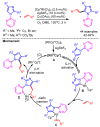Recent Developments in Transition-Metal Catalyzed Direct C-H Alkenylation, Alkylation, and Alkynylation of Azoles
- PMID: 33121108
- PMCID: PMC7662665
- DOI: 10.3390/molecules25214970
Recent Developments in Transition-Metal Catalyzed Direct C-H Alkenylation, Alkylation, and Alkynylation of Azoles
Abstract
The transition metal-catalyzed C-H bond functionalization of azoles has emerged as one of the most important strategies to decorate these biologically important scaffolds. Despite significant progress in the C-H functionalization of various heteroarenes, the regioselective alkylation and alkenylation of azoles are still arduous transformations in many cases. This review covers recent advances in the direct C-H alkenylation, alkylation and alkynylation of azoles utilizing transition metal-catalysis. Moreover, the limitations of different strategies, chemoselectivity and regioselectivity issues will be discussed in this review.
Keywords: C–H activation; C–H functionalization; alkenylation; alkylation; alkynylation; azoles; transition metal-catalysis.
Conflict of interest statement
The authors declare no conflict of interest.
Figures





































































Similar articles
-
Nickel-Catalyzed C-H Bond Functionalization of Azoles and Indoles.Chem Rec. 2021 Dec;21(12):3573-3588. doi: 10.1002/tcr.202100113. Epub 2021 Jun 1. Chem Rec. 2021. PMID: 34075686 Review.
-
Accessing C2-Functionalized 1,3-(Benz)azoles through Transition Metal-Catalyzed C-H Activation.Chemistry. 2021 Jul 21;27(41):10533-10557. doi: 10.1002/chem.202100475. Epub 2021 Jun 4. Chemistry. 2021. PMID: 33909304 Review.
-
1,1-Dibromo-1-alkenes as valuable partners in the copper-catalyzed direct alkynylation of azoles.Org Lett. 2010 Sep 17;12(18):4038-41. doi: 10.1021/ol1016433. Org Lett. 2010. PMID: 20735077
-
Recent advances in the transition metal-catalyzed twofold oxidative C-H bond activation strategy for C-C and C-N bond formation.Chem Soc Rev. 2011 Oct;40(10):5068-83. doi: 10.1039/c1cs15082k. Epub 2011 Jun 6. Chem Soc Rev. 2011. PMID: 21643614 Review.
-
Recent advances in transition-metal-catalyzed synthesis of conjugated enynes.Org Biomol Chem. 2016 Jul 12;14(28):6638-50. doi: 10.1039/c6ob00944a. Org Biomol Chem. 2016. PMID: 27291346 Review.
Cited by
-
A One-Pot Synthesis-Functionalization Strategy for Streamlined Access to 2,5-Disubstituted 1,3,4-Oxadiazoles from Carboxylic Acids.J Org Chem. 2022 Sep 16;87(18):12498-12505. doi: 10.1021/acs.joc.2c01669. Epub 2022 Sep 2. J Org Chem. 2022. PMID: 36054913 Free PMC article.
-
Lewis acid mediated, mild C-H aminoalkylation of azoles via three component coupling.Chem Sci. 2021 Feb 5;12(11):3890-3897. doi: 10.1039/d0sc06868c. Chem Sci. 2021. PMID: 34163658 Free PMC article.
-
Regio- and Chemoselective Palladium-Catalyzed Additive-Free Direct C─H Functionalization of Heterocycles with Chloroaryl Triflates Using Pyrazole-Alkyl Phosphine Ligands.Adv Sci (Weinh). 2024 Jun;11(21):e2309192. doi: 10.1002/advs.202309192. Epub 2024 Mar 14. Adv Sci (Weinh). 2024. PMID: 38482750 Free PMC article.
-
Ni/NHC-catalyzed C5-H alkylation and alkenylation of challenging furan(thiophene)-2-carboxaldehydes enabled by recyclable imine protecting group.Commun Chem. 2025 Aug 22;8(1):253. doi: 10.1038/s42004-025-01653-5. Commun Chem. 2025. PMID: 40846891 Free PMC article.
-
Total Synthesis of the Antimycobacterial Natural Product Chlorflavonin and Analogs via a Late-Stage Ruthenium(II)-Catalyzed ortho-C(sp2)-H-Hydroxylation.Pharmaceuticals (Basel). 2022 Aug 10;15(8):984. doi: 10.3390/ph15080984. Pharmaceuticals (Basel). 2022. PMID: 36015133 Free PMC article.
References
-
- Grimmett M.R. In: Comprehensive Heterocyclic Chemistry II. Katritzky A.R., Scriven E.F.V., editors. Volume 3. Pergamon; Oxford, UK: 1996. pp. 77–220.
-
- Woolley B.Y.D.W. From the laboratories. J. Biol. Chem. 1944;152:225–233.
Publication types
MeSH terms
Substances
LinkOut - more resources
Full Text Sources

